What Is Oaxacan Mole? A Sublime 5-Minute Guide
Disclosure: This post may contain affiliate links, meaning that I may get a small commission if you decide to make a purchase through my links, at no cost to you.
Have you been reading about Oaxacan food and wondered, what is Oaxacan mole?
Oaxacan mole is a traditional sauce that blends a diverse array of ingredients such as chiles, chocolate, spices, and nuts. According to Statista, mole is regarded as one of the most representative dishes of Mexican gastronomy.
There are literally hundreds of amazing variations of mole, although there are 7 primary variants that are normally associated with the Oaxaca masterpiece.
Getting hungry yet? Whet your appetite with us as we explore this unique culinary gem!
What Is Oaxacan Mole?
What Is Oaxacan Mole?
How Do You Pronounce Mole?

Let’s briefly look at how to pronounce the word mole. It can be confusing because although it has the same spelling as the English animal that digs up gardens, it is pronounced very differently!
In Spanish, there are two syllables in the word mole. The accent is on the first syllable.
If we break them up, you get MOE – LAY.
The first part is pronounced “MOE“, like Moe the bartender in The Simpsons. The second bit is pronounced “LAY“, like in laying down to go to sleep.
So, putting it together, Oaxaca is pronounced MOE – LAY. Simple, right?
Then let’s turn our attention back to answering the question, what is Oaxacan mole?
We can start by taking a very brief look at its history.
What Is Oaxacan Mole?
What Is The History Of Oaxacan Mole?
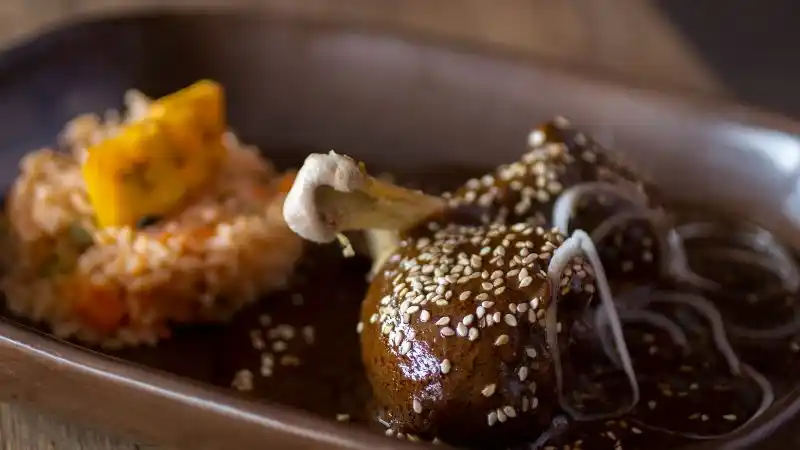
The word mole originates from the Nahuatl word “mulli,” meaning sauce or mixture.
Oaxacan mole dates back to pre-Hispanic times when indigenous peoples of the region used various ingredients to create flavorful sauces for their meals.
The arrival of the Spanish in the 16th century marked a pivotal moment in the evolution of mole. Indigenous chiles and spices combined with ingredients brought by the Spanish, such as chocolate and various spices, to create the intricate flavor profiles characteristic of Oaxacan mole.
Over time, mole recipes diversified across the region, leading to the emergence of distinct types, each with its own combination of ingredients and flavors.
Families, communities, and regions crafted their own interpretations, often passing down recipes through generations.
Oaxacan mole gained international recognition during the 20th century as Mexican cuisine gained prominence worldwide.
Mole’s complexity and rich history positioned it as a cultural ambassador, representing the depth and diversity of Oaxaca’s culinary heritage.
What Is Oaxacan Mole?
What is Oaxacan Mole Made Of?
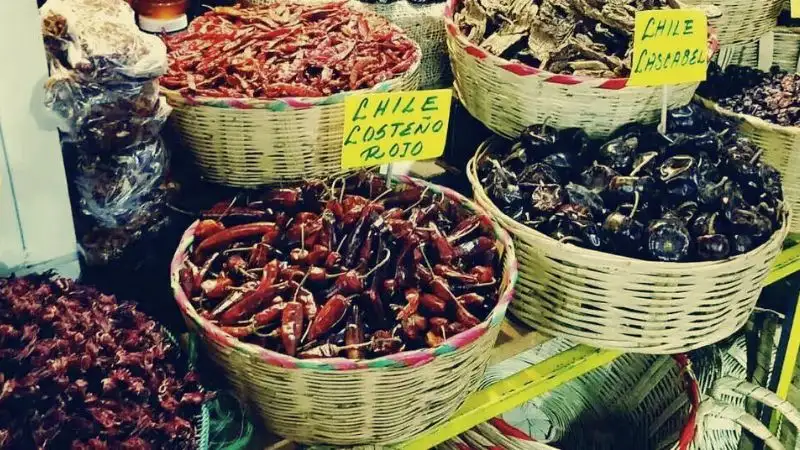
The next obvious question after what is Oaxacan mole is what is Oaxacan mole made from?
The answer varies a little, as Oaxacan mole is a complex sauce that varies widely from recipe to recipe and type to type. Some mole recipes can have more than 20 ingredients, while others may have fewer.
The key ingredients often include chiles, spices, chocolate, nuts, seeds, fruits, and various seasonings. The exact number of ingredients can depend on factors such as regional variations, family traditions, and personal preferences.
At the heart of Oaxaca mole are chiles, which play a pivotal role in determining its heat level and depth of flavor. An array of chiles, ranging from mild to fiery, are roasted and ground to create the base of the sauce.
In addition to chiles, mole incorporates a variety of spices, such as cinnamon, cloves, and cumin, each adding distinct layers of aroma and taste.
Chocolate, a unique hallmark of Oaxacan mole, adds an unexpected yet delightful dimension. This bitter-sweet ingredient contributes a velvety texture and deepens the sauce’s complexity.
Nuts, often almonds or peanuts, lend a creamy consistency and nutty undertones.
The sauce is thickened with masa (corn dough) or bread, providing body and richness. Fruits, such as tomatoes, tomatillos, and plantains, offer a hint of sweetness that balances the heat of the chiles.
Let’s take a look at the seven archetypal forms of mole, and you will start to get a sense of the diverse possibilities of this complex sauce.
What Is Oaxacan Mole?
How Do You Make Oaxacan Mole?
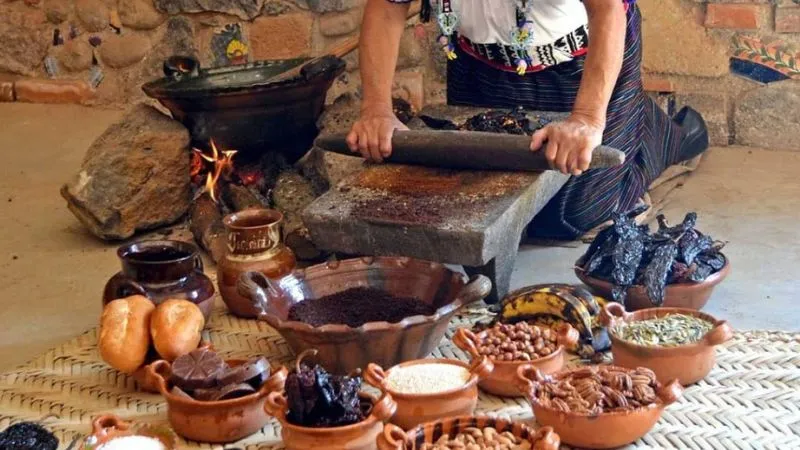
The process of preparing mole is labor-intensive, often involving hours of simmering and constant stirring to achieve the desired depth of flavor and consistency.
There are a number of steps in the complex mole preparation process. We’ve taken a look at each of these below.
What Is Oaxacan Mole?
Selecting Ingredients
Mole begins with the careful selection of ingredients.
Different types of chiles, spices, nuts, seeds, and even chocolate form the foundation of various mole recipes. Each ingredient contributes to the distinct flavor profile.
Oaxaca has a number of brilliant markets where fresh high-quality ingredients can readily be obtained, such as Mercado Benito Juárez and Mercado 20 De Noviembre.
Once all of the relevant base ingredients have been selected and purchased, the production process can begin.
What Is Oaxacan Mole?
Toasting and Roasting
After the relevant ingredients have been bought, the next step is to toast and then roast the ingredients.
Toasting involves gently heating dry ingredients, like chiles, seeds, and spices, in a dry skillet or comal (a traditional griddle) to intensify their natural flavors and to release their essential oils.
As the ingredients warm, their natural oils are coaxed to the surface, resulting in enhanced aromatics. The toasting process also slightly changes the texture of the ingredients, making them more pliable for grinding.
Roasting involves exposing ingredients to direct heat, like an open flame or in an oven. Chiles, tomatoes, garlic, and even chocolate can be roasted.
Roasting tomatoes and garlic mellows their bitterness and adds a touch of sweetness. Roasting chocolate deepens its richness and complements the other flavors in the mole.
What Is Oaxacan Mole?
Grinding and Blending
After toasting and roastig, the ingredients are ground to a fine consistency using traditional tools like a metate (stone grinding slab) or modern kitchen appliances such as blenders or food processors.
The ground ingredients are transformed into a paste or powder, ready to be combined into the mole base.
This step is crucial for achieving the desired texture and ensuring that the flavors are uniformly integrated.
What Is Oaxacan Mole?
Creating the Mole Base
The ground ingredients are combined to form the mole base.
This mixture, often referred to as “mole paste,” serves as the foundation of the sauce.
Additional liquids, such as broth, water, or stock from meat that’s being prepared with the mole, are gradually added to create a thick and flavorful base.
The process requires patience and precision to achieve the right consistency and balance of flavors.
What Is Oaxacan Mole?
Simmering and Infusing
The mole base is simmered over low heat, allowing the flavors to meld and infuse.
This slow cooking process is essential for developing the depth and complexity that mole is known for.
Frequent stirring prevents scorching and ensures that the ingredients fully incorporate. As the mole simmers, its aroma fills the kitchen, building anticipation for the final dish.
What Is Oaxacan Mole?
Adding Chocolate and Final Adjustments
As the mole simmers, chocolate is introduced to the sauce.
This addition brings a rich and velvety texture while imparting a subtle bitterness that counterbalances the sweetness of other ingredients.
The balance of flavors is fine-tuned with additional spices, salt, and occasionally sweeteners.
This stage is an intricate dance of taste adjustments, where the cook’s experience and intuition play a crucial role in achieving the desired complexity and harmony of flavors.
What Is Oaxacan Mole?
What Are The Seven Definitive Types Of Oaxaca Mole?
There are seven major varieties of Oaxacan mole, each with its distinct ingredients and characteristics.
These are Mole Negro, Mole Rojo, Mole Coloradito, Mole Amarillo, Mole Verde, Mole Chichilo, and Mole Manchamanteles.
Each mole is carefully prepared using a different combination of chilies, spices, nuts, seeds, and other ingredients, resulting in a sauce with a unique flavor profile.
Let’s look at each of these in a little more detail.
What Is Oaxacan Mole?
Mole Negro

Mole Negro (black mole) is the most iconic and complex of all moles.
This intricate sauce boasts a harmonious blend of ingredients, including a variety of chiles, spices, chocolate, and more.
A slow and meticulous preparation process results in its deep, velvety darkness and its complex flavor profile.
Mole Negro is traditionally paired with poultry, often turkey or chicken, allowing the tender meat to absorb the depths of this dark delight.
What Is Oaxacan Mole?
Mole Rojo
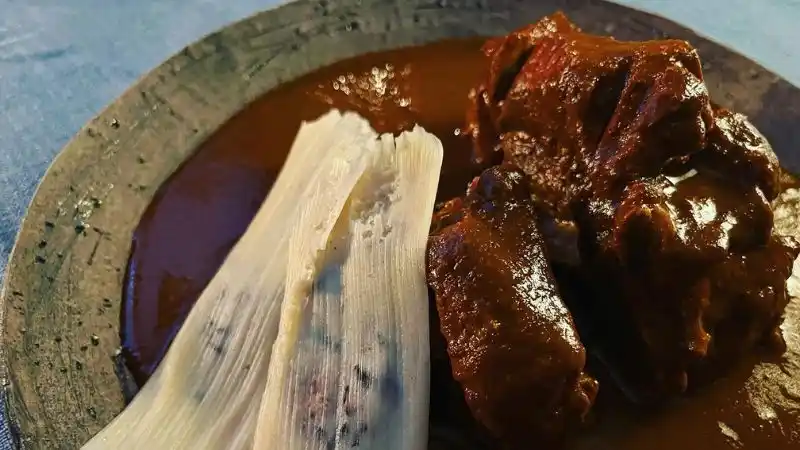
Mole Rojo is recognisable from its deep red hue and robust flavors.
It is crafted from a blend of dried chiles, tomatoes, spices, and herbs and delivers a delightful balance of tanginess and warmth.
It’s a versatile companion, pairing gracefully with meats like chicken, pork, or beef.
What Is Oaxacan Mole?
Mole Coloradito
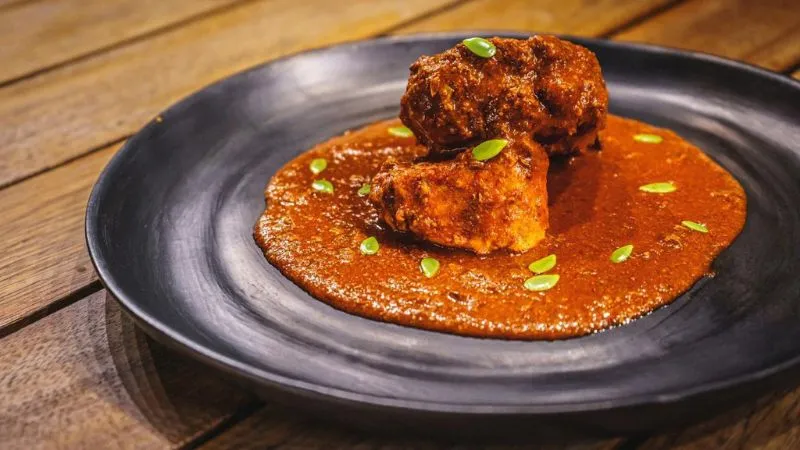
Mole Coloradito boasts a captivating reddish-brown hue derived from ancho and guajillo chiles.
This intricate sauce marries the earthy warmth of these chiles with a medley of spices, garlic, almonds, and tomatoes.
Chocolate undertones contribute to its nuanced flavor profile, balancing sweetness with a touch of bitterness.
Mole Coloradtio is typically served with chicken or pork and enchants taste buds with its unique blend of ingredients.
What Is Oaxacan Mole?
Mole Amarillo

Mole Amarillo derives its sunny color from a blend of guajillo and costeño amarillo chiles.
The sauce’s vibrant appearance reflects its lively flavor profile, featuring notes of tanginess from tomatillos, warmth from chiles, and aromatic spices.
A touch of epazote lends a herbal undertone, while garlic and onion provide depth.
Mole Amarillo’s delightful complexity is further elevated with the addition of chicken, enhancing its savory nuances.
What Is Oaxacan Mole?
Mole Verde
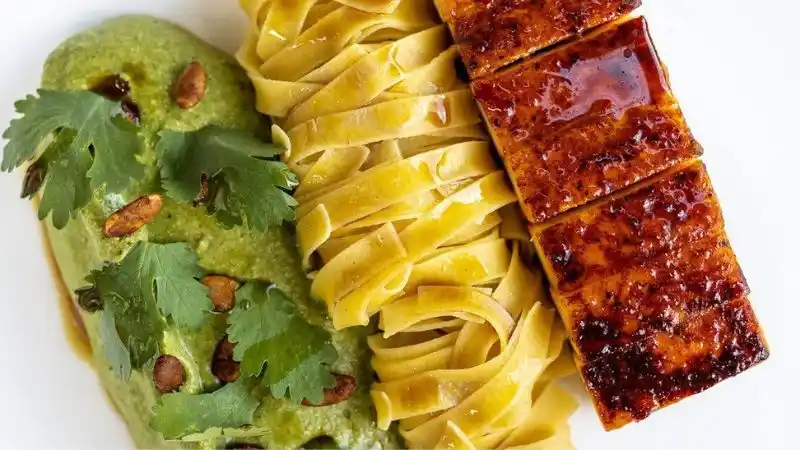
Mole Verde is a mole that is known for its fresh and herbal essence.
This vibrant sauce derives its color from tomatillos and serrano chiles, crafting a zesty foundation.
Aromatic herbs like epazote and cilantro contribute a distinctive aroma, while pumpkin seeds add texture and nuttiness.
Mole Verde’s tangy and bright profile harmonizes with chicken or pork, creating a refreshing and dynamic combination.
What Is Oaxacan Mole?
Mole Chichilo
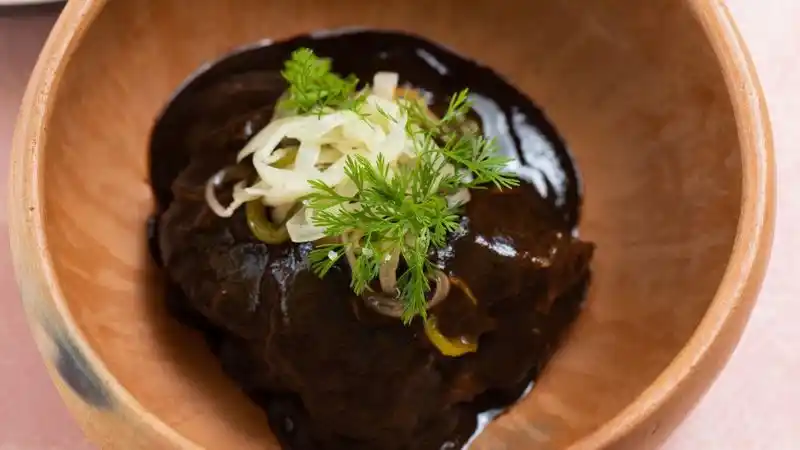
Mole Chichilo has a captivating smoky flavor achieved through the use of roasted blackened chilhuacle negro chiles.
This unique sauce is enriched with the earthy essence of avocado leaves and a hint of hoja santa.
A medley of spices, including cloves and cumin, infuse complexity, while blackened tortillas and masa thicken the sauce.
Mole Chichilo’s dark and velvety texture is a testament to its meticulous preparation.
Traditionally paired with beef, this smoky and aromatic delight offers a glimpse into Oaxaca’s dedication to crafting distinct and unforgettable culinary experiences.
What Is Oaxacan Mole?
Mole Manchamanteles
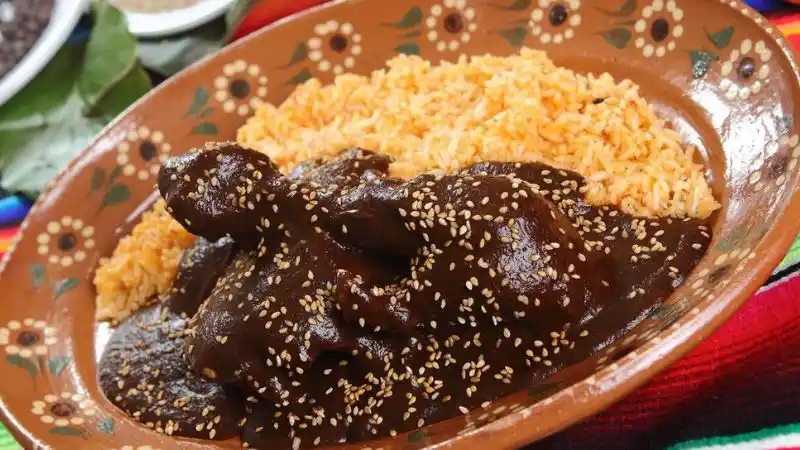
Mole Manchamanteles, the “tablecloth stainer,” is a Oaxacan creation blending sweet and spicy notes.
Its rich reddish-orange hue is achieved through a blend of ancho chiles, plantains, and pineapple, which contribute to its delightful sweetness.
A medley of spices and tomatoes adds depth, while sesame seeds impart a subtle nuttiness.
This unique mole often accompanies pork or chicken, offering a symphony of contrasting flavors and textures.
What Is Oaxacan Mole?
What Are Some Other Popular Oaxacan Moles?
In addition to the famous seven Oaxaca moles, there are also a few other moles that are so well-known that they should also be mentioned here.
Mole Poblano

Mole Poblano is a savory-sweet mole that combines rich chocolate, dried chiles, spices, and toasted nuts to create a complex symphony of flavors.
Its deep brown hue and velvety texture make it visually enticing.
Traditionally served over turkey or chicken, Mole Poblano’s marriage of earthy, smoky, and sweet notes captivates the palate.
What Is Oaxacan Mole?
Mole Estofado

Mole Estofado, also known as “stewed mole,” is a lesser-known but equally flavorful variation of Oaxacan mole.
Originally from the Mixteca region of Oaxaca, this mole boasts a rich blend of ingredients such as chiles, tomatoes, garlic, and aromatic spices.
What sets it apart is its distinctive preparation method. The sauce is slowly stewed or simmered to achieve a deeply concentrated flavor.
Mole Estofado often graces the tables during special occasions, offering a taste of the Mixteca’s culinary heritage.
What Is Oaxacan Mole?
Mole Almendrado

Mole Almendrado is characterized by its rich and nutty essence.
This exquisite mole incorporates almonds as a primary ingredient, lending a creamy texture and distinct flavor to the sauce.
The dish is often elevated with the addition of chicken or turkey, allowing the meat to soak in the sumptuous almond-infused flavors.
What Is Oaxacan Mole?
What Are The Best Pairings For The 7 Oaxacan Moles?
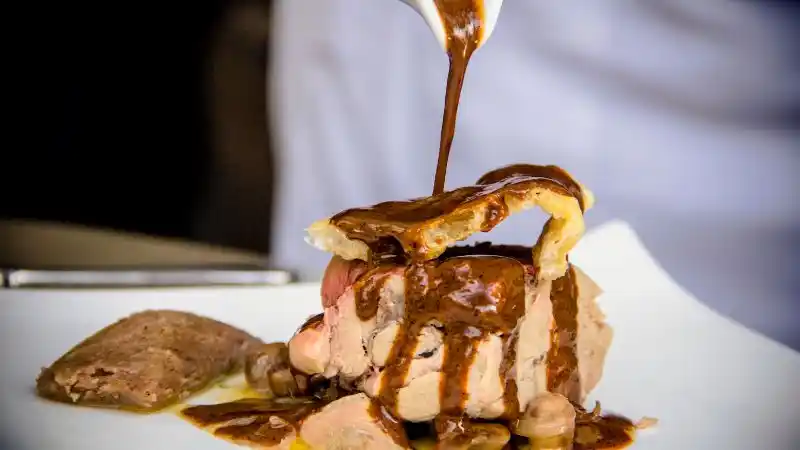
If you’re looking a for a quick guide on suggested pairings, we’ve put one together for you below:
1. Mole Negro
Pairing
Chicken or Turkey.
Drink
A robust red wine, such as a Syrah or Zinfandel, enhances the complex flavors of Mole Negro.
Basis of Pairing
The rich, deep flavors of Mole Negro complement the tender and savory qualities of chicken or turkey, creating a harmonious balance of taste and texture.
What Is Oaxacan Mole?
2. Mole Rojo
Pairing
Enchiladas.
Drink
A medium-bodied red wine, such as a Merlot or Tempranillo, complements the flavors of Mole Rojo and enchiladas.
Basis of Pairing
The earthy flavors of Mole Rojo provide a comforting and rich backdrop for the cheese and tortillas in enchiladas, offering a delightful contrast of textures.
What Is Oaxacan Mole?
3. Mole Coloradito
Pairing
Pork tamales.
Drink
A Mexican lager or a light ale refreshes the palate and complements the flavors of Mole Coloradito.
Basis of Pairing
The mild heat and vibrant flavor of Mole Coloradito enhance the savory nature of pork, enhancing the overall taste experience.
What Is Oaxacan Mole?
4. Mole Amarillo
Pairing
Fish tacos.
Drink
A crisp and citrusy white wine, like a Sauvignon Blanc, pairs well with the fresh flavors of fish tacos and Mole Amarillo.
Basis of Pairing
The delicate flavors of fish are enhanced by the aromatic and slightly spicy notes of Mole Amarillo, creating a delightful contrast of tastes.
What Is Oaxacan Mole?
5. Mole Verde
Pairing
Grilled vegetables.
Drink
A refreshing herbal tea or a light beer, such as a pilsner, complements the herbal notes of Mole Verde.
Basis of Pairing
The herbal and vegetal undertones of Mole Verde complement the smoky flavors of grilled vegetables, resulting in a fresh and satisfying combination.
What Is Oaxacan Mole?
6. Mole Chichilo
Pairing
Beef stew.
Drink
A rich and bold stout or porter beer enhances the richness of both Mole Chichilo and beef stew.
Basis of Pairing
The intense flavors of Mole Chichilo pair well with the hearty and robust nature of beef stew, creating a deeply satisfying and hearty dish.
What Is Oaxacan Mole?
7. Mole Manchamanteles
Pairing
Grilled pineapple and chicken skewers.
Drink
A tropical fruit-infused cocktail, like a piña colada, echoes the fruity flavors of Mole Manchamanteles and grilled pineapple.
Basis of Pairing
The fruity and slightly sweet notes of Mole Manchamanteles harmonize with the grilled pineapple, while the chicken adds a savory element to the mix.
What Is Oaxacan Mole?
What Role Does Oaxacan Mole Have In Oaxacan Festivals?

Oaxacan mole plays a significant role in various festivals across the region, adding flavor and cultural depth to the celebrations.
We’ve set out a few examples of its use in Oaxacan festivals below.
La Guelaguetza
This iconic festival showcases the diverse cultures of Oaxaca through traditional dances, music, and, of course, cuisine.
Mole is a centerpiece of the feast during La Guelaguetza, served alongside traditional dishes as a symbol of the region’s culinary richness.
Day of the Dead (Dia de los Muertos)
Mole is often prepared as an offering for deceased loved ones during Dia de los Muertos.
Families set up altars with favorite foods of the departed, including mole, believing that the aroma will guide the spirits back to the living world to enjoy their favorite dishes.
Noche de Rábanos (Night of the Radishes)
While not directly used in the radish-carving competition, mole is a popular dish served during the Noche de Rábanos festivities.
After the intricate radish sculptures are displayed, attendees enjoy a range of Oaxacan dishes, with mole often taking center stage.
Fiestas de la Soledad
In Oaxaca’s Huayapan municipality, the Fiestas de la Soledad celebrate the patron saint of the town.
Mole negro, the famous dark mole, is a prominent feature of the celebratory feast, symbolizing the communal spirit and cultural heritage.
Candelaria Festival
During the Día de la Candelaria (Candlemas), mole tamales are a traditional dish served to commemorate the presentation of Jesus at the temple.
These tamales, made with the same care and precision as other mole dishes, carry cultural significance during this religious festival.
What Is Oaxacan Mole?
Myths And Misconceptions About Oaxacan Mole

Several myths and misconceptions surround Oaxacan mole, often obscuring its true nature and cultural significance.
We’ve set out below a few common misconceptions.
All Moles Are the Same
One significant misconception is that all moles are identical in flavor and preparation.
In reality, Oaxacan mole encompasses a diverse array of types, each with distinct ingredients, flavors, and methods of preparation.
Mole Is Always Spicy
While chiles are a prominent ingredient, not all moles are extremely spicy.
Some varieties, like mole amarillo, prioritize flavor over heat, showcasing the complexity of Oaxacan cuisine.
Mole Is Just Chocolate Sauce
While chocolate is a component, mole is far more intricate than a simple chocolate sauce.
Chocolate adds depth and texture, but it’s just one element in the symphony of flavors.
Making Mole Is Quick and Easy
Preparing authentic mole is a labor-intensive process that involves roasting, grinding, and simmering numerous ingredients.
It’s not a quick endeavor and requires patience and skill.
Mole Is Only a Sauce
While mole is often associated with sauces, it can also be a marinade, a seasoning, or even a component in other dishes.
Its versatility extends beyond its saucy reputation.
Mole’s Flavor Can’t Be Adapted
While tradition is vital, chefs and home cooks can put their unique spin on mole, adapting it to suit their taste preferences while still respecting its core elements.
Mole Should Be Eaten Only with Certain Dishes
Although mole pairs wonderfully with classics like chicken and rice, it’s also open to experimentation.
It can elevate a variety of dishes, from tacos to enchiladas.
Mole Is Only For Special Occasions
Mole is enjoyed year-round and isn’t exclusive to celebratory events.
It’s a staple of Oaxacan cuisine that’s relished in everyday meals as well.
Authentic Mole Can Only Be Found in Restaurants
Many families prepare their mole recipes at home, and the diversity of recipes ensures you can find authentic versions both in restaurants and households.
What Is Oaxacan Mole?
What is Oaxacan Mole: FAQs

We’ve set out below some frequently asked questions in connection with Oaxacan mole.
What Does Oaxacan Mole Taste Like?
Mole’s taste is a harmonious blend of rich, earthy, and spicy notes.
Depending on the type, you’ll find elements of chocolate, chiles, spices, and sometimes sweetness.
It’s a complex tapestry of flavors, capturing Oaxaca’s culinary heritage in every nuanced bite.
Is Mole From Oaxaca Sweet?
Yes, some Oaxacan moles can have a touch of sweetness.
Depending on the type, ingredients like chocolate, dried fruits, or sweeteners are used, adding subtle sweetness that balances the savory and spicy flavors.
The level of sweetness varies, creating a harmonious blend of tastes.
What Is The Most Complicated Mole?
Mole Negro is often considered the most intricate Oaxacan mole.
It demands a meticulous blend of chiles, spices, and chocolate, simmered to perfection.
Its complex process and rich, velvety flavors make it a culinary masterpiece, showcasing Oaxaca’s dedication to crafting the finest of moles.
What Is The Best Kind Of Mole?
The “best” Oaxacan mole depends on personal preference, as each type offers a unique experience.
Mole Negro’s depth and complexity, Mole Coloradito’s warmth, and Mole Amarillo’s zesty tang are just a few examples.
Exploring the rich variety allows you to discover your own favorite among these culinary delights. However, if you only had time to try one, you might try Mole Negro simply because it is the most well-known.
What is the most popular mole in Oaxaca?
Mole Negro holds a place of prominence as one of the most popular Oaxacan moles.
Its intricate blend of flavors, combined with its rich history and deep, velvety texture, captures the essence of Oaxacan cuisine and has earned it a special place on many tables and in many hearts.
What Is Oaxacan Mole?
Final Thoughts
Now that you’ve made it to the end, I hope you’ve worked up an appetite!
Oaxacan mole is one of the flagship dishes in Oaxacan cuisine, and no trip to Oaxaca would be complete without trying at least a few of the hundreds of different types of mole available.
It’s also something that you can absolutely experiment with at home, so that you work up an appetite before trying the real thing in Oaxaca!
Make sure it’s on your Oaxaca bucket-list when you get there!
Buen viaje!
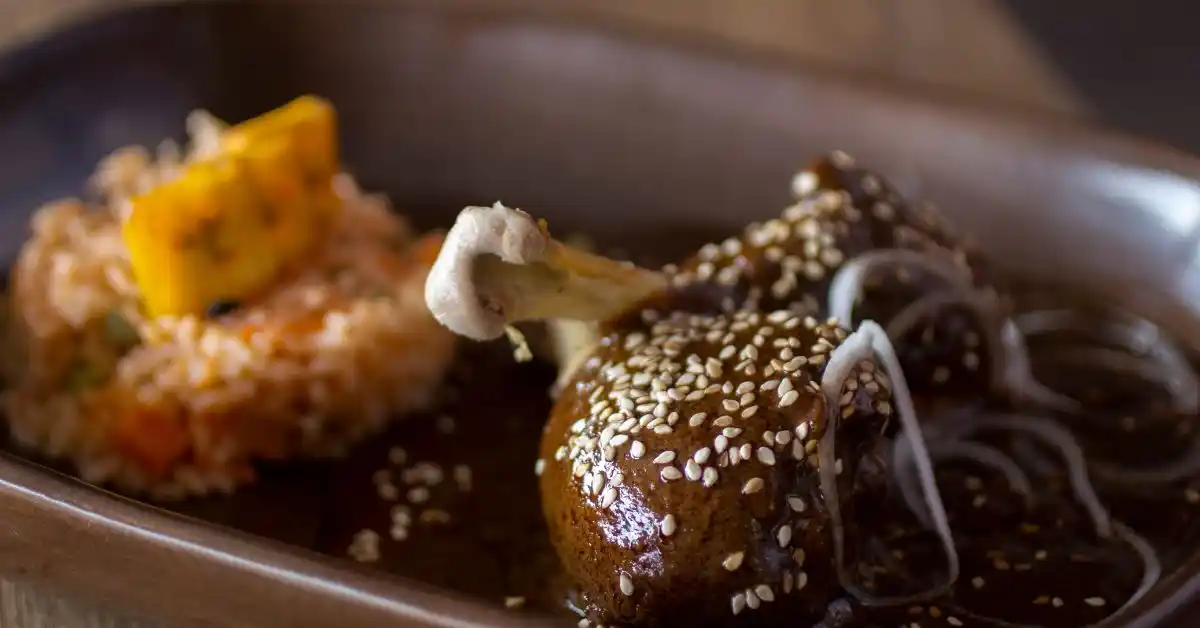
![Morelia to Mexico City: 7 Best Ways to Travel [2024]](https://capricioustravel.com/wp-content/uploads/2024/02/Morelia-to-Mexico-City-Morelia-Cathedral-and-Mexico-City-Metropolitan-Cathedral.webp)
![Mexico City to Zipolite: 5 Best Ways to Travel [2024]](https://capricioustravel.com/wp-content/uploads/2024/01/Mexico-City-to-Zipolite-Metropolitan-Cathedral-and-Playa-del-Amor.webp)
![How To Pronounce Oaxaca: An Easy Guide [2024]](https://capricioustravel.com/wp-content/uploads/2023/08/How-To-Pronounce-Oaxaca-2-800x419.jpg)
![Guadalajara to Uruapan: 5 Best Ways to Travel [2024]](https://capricioustravel.com/wp-content/uploads/2024/03/Guadalajara-to-Uruapan-Guadalajara-Cathedral-and-Uruapan-Town-Center.webp)
![Casa Oaxaca Hotel: The Definitive Review [2024]](https://capricioustravel.com/wp-content/uploads/2023/11/Casa-Oaxaca-Hotel-Master-Suite-Stairway-and-Lobby-800x450.webp)
![NaNa Vida Hotel Oaxaca: The Definitive Review [2024]](https://capricioustravel.com/wp-content/uploads/2023/11/NaNa-Vida-Hotel-Oaxaca-Interior-Courtyard-800x450.webp)